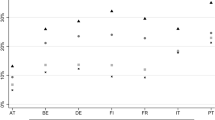Abstract
There are three challenges to household economic security: Slow income growth at the lower and middle parts of the income distribution, swings in households’ use of debt and leverage, and large numbers of households with low savings. Appropriate policy responses to these include increasing worker skills through greater opportunities for education and training, removing barriers to labor force participation, strengthening the safety net, improving access to credit while reducing exposure to harmful aspects of debt use, and making retirement savings easier and more automatic.










Similar content being viewed by others
Notes
Here, I am defining mortgage leverage as the ratio of mortgage debt to housing assets.
See Dynan [2012]. Highly leveraged households are defined as those in the highest quintile of debt relative to assets as of 2007. Housing boom states are defined as those in the top quartile of home price appreciation between 2000 and 2006.
The figures cited are U.S. Treasury staff calculations based on data from the 2013 Survey of Consumer Finances, available at http://www.federalreserve.gov/econresdata/scf/scfindex.htm.
You can learn more about the program by visiting www.myRA.gov.
References
Beshears, John, James J. Choi, David Laibson and Brigitte C. Madrian . 2012. Default Stickiness among Low-Income Individuals. Rand Corporation Working Paper. https://www.rand.org/content/dam/rand/www/external/labor/seminars/adp/pdfs/2012/choi.pdf (accessed March 1, 2016).
Bricker, Jesse, Lisa J. Dettling, Alice Henriques, Joanne W. Hsu, Kevin B. Moore, John Sabelhaus, Jeffrey Thompson and Richard A. Windle . 2014. “Changes in U.S. Family Finances from 2010 to 2013: Evidence from the Survey of Consumer Finances.” Federal Reserve Bulletin, 100 (4).
Bureau of Labor Statistics, 2015. Employee Benefits in the United States – March 2015. http://www.bls.gov/news.release/pdf/ebs2.pdf (accessed March 1, 2016).
Chetty, Raj, John N. Friedman, Soren Leth-Petersen, Torben Neilsen and Tore Olsen . 2014. “Active vs. Passive Decisions and Crowdout in Retirement Savings Accounts: Evidence from Denmark.” Quarterly Journal of Economics, 129 (3): 1141–1219.
Congressional Budget Office, 2014. The Distribution of Household Income and Federal Taxes, 2011.https://www.cbo.gov/sites/default/files/113th-congress-2013-2014/reports/49440-Distribution-of-Income-and-Taxes-2.pdf.
Dynan, Karen . 2012. “Is a Household Debt Overhang Holding Back Consumption?” Brookings Papers on Economic Activity, 44 (spring): 299–344.
Dynan, Karen, Douglas Elmendorf and Daniel Sichel . 2012. “The Evolution of Household Income Volatility.” The B.E. Journal of Economic Analysis and Policy, 12 (2): 1–42.
FINRA Investor Education Foundation, 2012. Financial Capability in the United States. http://www.usfinancialcapability.org/downloads/NFCS_2012_Report_Natl_Findings.pdf, accessed February 28, 2016.
Hurst, Erik . 2008. “Understanding Consumption in Retirement: Recent Developments,” in Recalibrating Retirement Spending and Saving, edited by John Ameriks and Olivia Mitchell. Oxford University Press.
Riffkin, Rebecca . 2014. More Americans think they will retire comfortably. http://www.gallup.com/poll/168959/americans-think-retire-comfortably.aspx, accessed February 19, 2016.
Additional information
This paper is based on a presentation at the NABE Policy Conference on March 8, 2016.
*Dr. Karen Dynan serves as the U.S. Department of the Treasury’s Assistant Secretary for Economic Policy and Chief Economist. Dr. Dynan leads the Office of Economic Policy, which is responsible for analyzing and reporting on current and prospective economic developments and helping develop policies to address economic challenges. Dr. Dynan came to Treasury from the Brookings Institution, where she was vice president and co-director of the Economic Studies program. Prior to joining Brookings, she served on the staff of the Federal Reserve Board for 17 years. While at the Federal Reserve, she played a leadership role in a number of areas, including macroeconomic forecasting, tracking household finances, and the Federal Reserve’s response to the financial crisis. She has also served as a senior economist at the White House Council of Economic Advisers and as a visiting assistant professor at Johns Hopkins University in 1998. Dr. Dynan is an expert on macroeconomic policy and household financial issues who has published widely in leading economics journals. She received her Ph.D. in economics from Harvard University and her A.B. from Brown University
Rights and permissions
About this article
Cite this article
Dynan, K. Household Economic Security and Public Policy. Bus Econ 51, 83–89 (2016). https://doi.org/10.1057/be.2016.18
Published:
Issue Date:
DOI: https://doi.org/10.1057/be.2016.18




